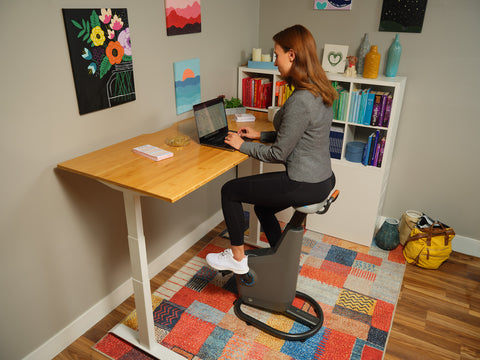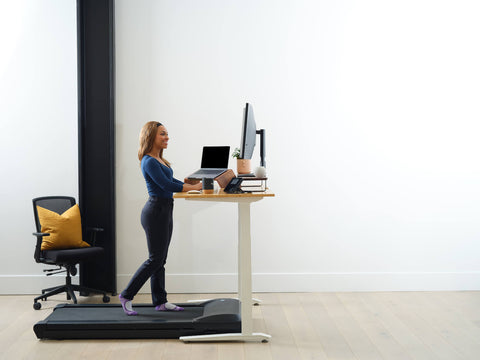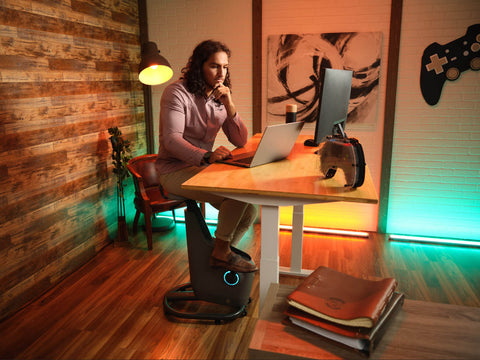Introducing balance training to weekly workout routine can provide a handful of benefits. Preforming balance board exercises can help prevent injury, aid in rehabilitation, improve posture, reduce back pain, improve coordination and body awareness, and keep you more alert. Plus, it’s fun and easy to do! Balance board exercises are great for beginners and seasoned athletes alike. Learn more about balance board benefits.
You’ll find that balance boards come in a variety of shapes and sizes. You’ll even find a wide array of naming conventions. That said, you should be able to execute all exercises shown below on any board, whether it’s a wobble board, a rocker, or a balance board. However, all demonstrations shown below are done using the LifeSpan AirSoft Standing Board.
All exercises below will require you have a balance board, workout attire, hand weights, and a weight ball. If you don’t have access to weights or a weighted ball, that’s perfectly fine, you can still complete the exercises without them or simply skip that exercise.
1. Squats

Targeted Muscles: Quads, hamstrings, glutes, core, and posterior muscles
How To: You’ll want to start standing with your feet shoulder-width apart on the board. To help balance, you can extend your hands in front of you. Next, sit back like you are going to sit in an imaginary chair with you head continuing to look forward. Make sure your back remains straight with a neutral spine rather than rounding forward. Stop lowering once your thighs are parallel with the floor with your knees positioned over your feet and your body weight pressed back in your heels. Slowly begin to press back up to a standing position.
2. Lunges

Targeted Muscles: Calves, quads, glutes, hips, and hamstrings
How To: Start with your feet hip-width apart. Step forward with your right leg onto the balance board, shifting your body weight forward. Slowly lower yourself until your right thigh is parallel with the floor while making sure your back remains straight and upright. If you are comfortably able to, let your left knee slightly tap the floor. Slowly press back up by shifting your weight back into your right heel till you return to the starting position. Repeat these steps stepping with your left foot forward.
Note: To make this exercise more challenging, begin by standing on the balance board and stepping off into a lunge.
3. Incline Pushups
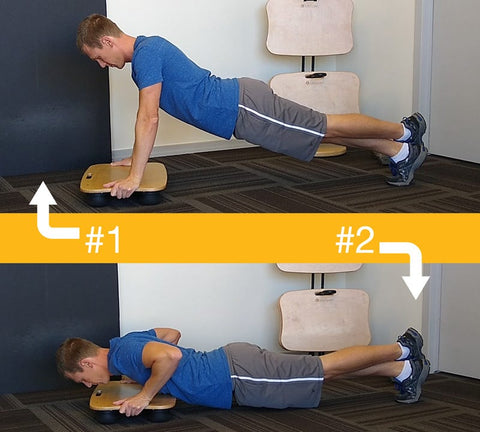
Targeted Muscles: Pectorals, deltoids, triceps, back muscles, and abdominals
How To: Begin with your hands placed on the balance board slightly wider than shoulder-width apart. Plant your feet behind you at a distance apart from one another that feels comfortable to you. Keep in mind that the further apart your feet are, the more stable you will be. Your body should form a straight line making sure that your butt isn’t sticking up or sagging. Keep your head looking slightly forward and your elbows slightly bent so they never lockout. Slowly begin to lower yourself as far down as you can go. If you can only go down until your arms are at a 90-degree angle that is completely fine. Pause at the bottom position, then push yourself back up to the starting position.
4. Decline Pushups

Targeted Muscles: Pectorals, deltoids, triceps, back muscles, and abdominals
How To: Begin with your hands placed on the floor slightly wider than shoulder-width apart. Plant your feet behind you on the balance board at a distance apart from one another that feels comfortable to you. Again, keep in mind that the further apart your feet are, the more stable you will be. Your body should form a straight line making sure that your butt isn’t sticking up or sagging. Keep your head looking slightly forward and your elbows slightly bent so they never lockout. Slowly begin to lower yourself as far down as you can go. Pause at the bottom position, then push yourself back up to the starting position.
5. Straight Arm Plank
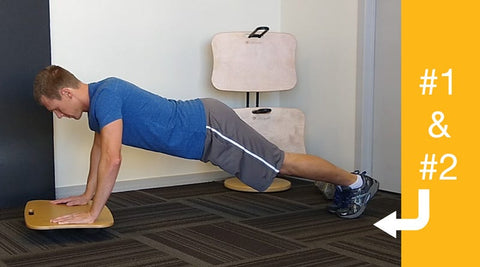
Targeted Muscles: Pectorals, deltoids, triceps, and abdominals
How To: Start with your hands placed on your board slightly wider than shoulder-width apart. Place your feet behind you at a comfortable distance. Your body should form a straight line making sure that your butt isn’t sticking up or sagging. Keep your head looking slightly forward and your elbows slightly bent so they don’t lockout. Continue to hold this position for as long as you can.
Note: To make this exercise more challenging, shift your body weight into either arm, lifting the other arm forward so your shoulder is touching your ear and your hand is straight in front of you. Repeat with the other arm.
6. Calf Raises
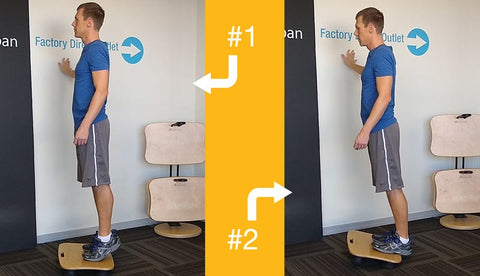
Targeted Muscles: Calf muscles (gastrocnemius, achilles tendon, soleus)
How To: Start by placing your feet toward one end of the board about at a distance that feels comfortable to you. You will want to place the board near a wall or something tall that you can place a hand on to support yourself as needed. Slowly shift your weight forward into the ball of your feet extending through your feet. Make sure to maintain a neutral head and back position. Pause at the top position and slowly shift your weight back into your heels till your return back to the starting position.
Note: To make this exercise more challenging, try a single-leg calf raise.
There are plenty of additional exercises that can be performed using a balance board that we haven’t shown above, so feel free to get creative and share it with us Instagram or Facebook using #mylifespan. Just make sure you are always maintaining proper form to prevent injury.





